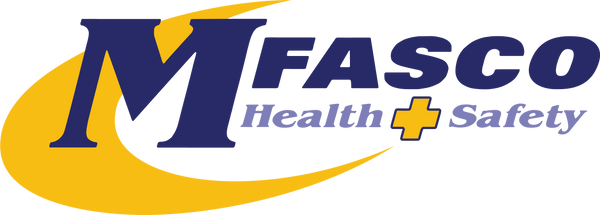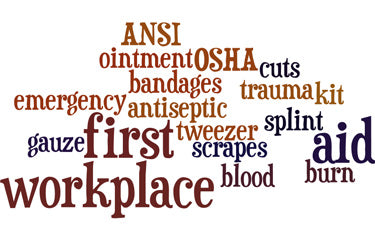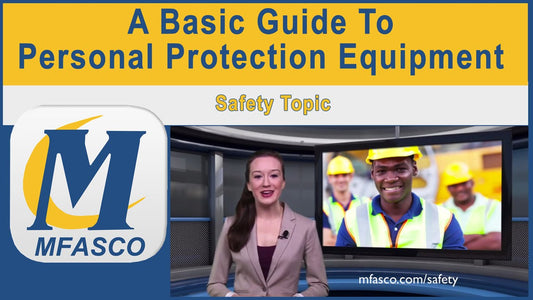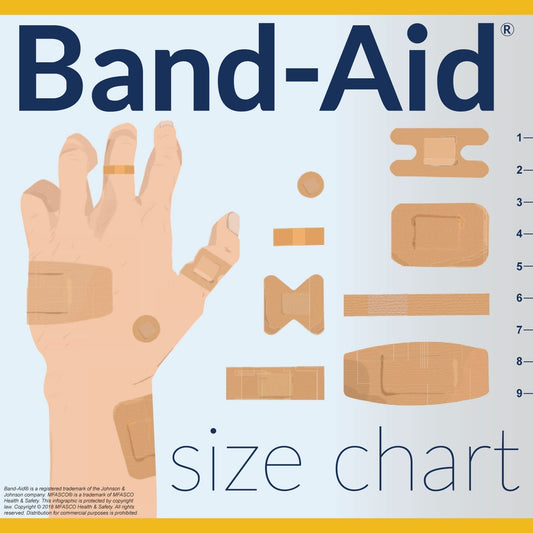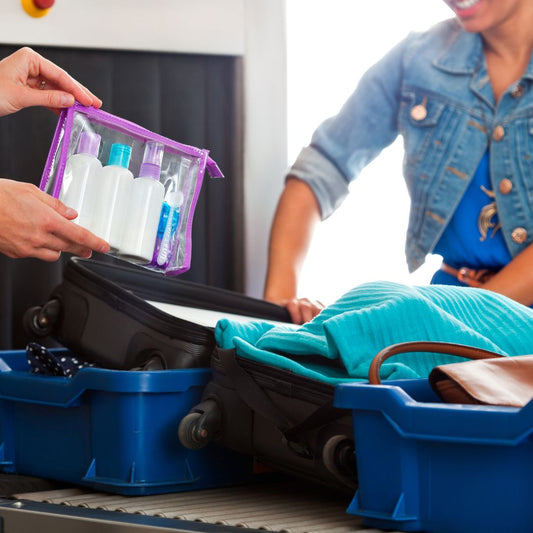How to Restock Your First Aid Kit

"How To Restock Your First Aid Kit" is the last of a three-part series showing you how to inspect, sanitize, and restock your first aid kit. In this article, we use a standard 4 shelf industrial first aid kit as an example; we also cover how to determine what supplies you need, how to create a checklist, and how to set up regular inspections.
1. How do I determine what first aid supplies I need for my kit?
While workplace first aid kits are required to contain at least the minimum OSHA/ANSI list of supplies, there may be other items your workplace should keep. Understanding the purpose of your kit, what potential injuries can occur, and the OSHA/ANSI requirements for your workplace (if applicable) will help you determine what first aid supplies are needed for your workplace.
Purpose and Use of your first aid kit
This is easy. The purpose of any first aid kit is to treat minor cuts, scrapes, burns, and other types of injuries. In the workplace, it is not only meant to help the employee but also to keep them productive on the job. The kit is not to be a first responder/EMT bag. It is for basic first aid that employee╒s can access. All of the supplies maintained in the first aid cabinet are common sense supplies that everyone is familiar with how to use. Identifying Potential injuries.
Identifying Potential injuries.
Carefully look at the past injuries you have treated. This will help determine the types of first aid supplies you will want to have available for use. Do you have cuts and scrapes? If yes then include a variety of bandages and gauze. Are you experiencing dust and particles in your eyes? If yes, consider including eyewash in your kit. Also, look at the environment you are in. Are you stocking a first aid kit for a sheet metal cutting operation? If so, MORE bandages, gauze, and blood pressure bandages should be included than normal. If there is welding or any type of heat then additional burn gel should be stocked. Flying particles, dust, or chemicals would require you to keep more eye wash-type products. Woodcutting would demand splinter tools and bandages. If this is for a home, simply consider how many bandages, gauze, and burns you have treated in the past year or two. Plan for any potential injury by having supplies ready. So, if you have never had someone severely cut, that does not mean you don't need a pressure bandage. Always keep basic first aid supplies on hand for any potential injury.
OSHA / ANSI requirements
If the first aid kit is for a workplace, OSHA (Occupational Safety & Health Administration) has requirements for first aid supplies at work. Generally speaking, if your business is in near proximity to a medical facility (10 minutes) you might not be required to have a first aid kit. But, it is common sense for every workplace to be prepared and have a basic first aid kit at a minimum, a first aid kit that will help treat minor cuts, scrapes, or burns. Why pay money to send your employee off-property to a clinic for a bandage? OSHA expects that workplace first aid kits are to maintain or exceed the ANSI (American National Standards Institute) standard. Most likely, your idea of a basic first aid kit will contain much more than the ANSI minimum requirements. We have a special article detailing the OSHA/ANSI first aid standard for workplace kits found here. The article answers all of the common questions and includes the current list of supplies required to keep in your first aid kit.
If you keep a record of your injuries, this can be very helpful in understanding the types of common injuries that occur. Under OSHA's new record-keeping regulations, record-keeping is not required for minor injuries or use of the first aid cabinet unless it causes time off work or the injury is treated off-site at a medical facility.
So, to answer the question, "How do I know what supplies I need?", you need to know the purpose of your first aid kit, identify your potential injuries, and also be sure to include ANSI-required items. Once you have a list, we can move on to the second step of refilling and restocking your first aid kit.
2. Create a Checklist
Based on step 1, you should create and keep a first aid checklist. If you need help, we have 4 different resources for you to check your first aid kit supplies.
Make A First Aid Kit- Create your own custom printable checklist at our website. You can select the container, and supplies and even give them a name. The list can be saved for quick and easy reordering
Reorder List- On the MFASCO website, search for each item you want to keep in your kit and add it to your "My Item List". When you need to reorder, simply go to the "Reorder List" page and print your list. Check your cabinet and mark off the items you need.
RestockKit- This is a simple graphical checklist. MFASCO Health & Safety has several checklists already made and ready to use for each of the industrial first aid kit types (2-5 shelves). Our RestockKit program uses a simple graphical checklist that will help you remember where each item is placed. When it is time to order, simply print off a checklist, check the cabinet, and then place your order here at MFASCO. If you have your own custom list several easy ways to create a checklist and methods to set up regular inspections. See a helpful "how to use ReStockKit" video here Refill This Kit Now - Every MFASCO brand workplace first aid kit has an easy-to-use refill list. A QR code is located on the kit which, when used, directs to the refill section for that first aid kit. This can be used as a checklist to inspect as well as reorder the necessary first aid supplies to maintain your first aid kit. You can also go to any product detail page and look for the "Refill This Kit" link. See the example picture here.
Refill This Kit Now - Every MFASCO brand workplace first aid kit has an easy-to-use refill list. A QR code is located on the kit which, when used, directs to the refill section for that first aid kit. This can be used as a checklist to inspect as well as reorder the necessary first aid supplies to maintain your first aid kit. You can also go to any product detail page and look for the "Refill This Kit" link. See the example picture here.
3. Restock & Refill
Once you have a checklist, go to your cabinet, and compare your list to what you currently have in your kit. By this time the only thing in your cabinet should be good usable inventory. Anything old, partially used, expired, etc.. should be thrown away. See our article on how to inspect your first aid cabinet.
Order Supplies Based on Usage
It is important you remember to plan for usage between now and the next time you inspect your kit. If you go through a lot of bandage strips, be sure to order enough to last you until the next time you order. Also, if you have 1/2 a box or less left, consider ordering another box. When you stock your kit you will combine the two boxes. Most boxes of bandages, ointments, and medicines are designed to have extra space to combine a new box with some leftover products. We will talk about mixing expiration dates in a moment. Complete your checklist and order your items.
Organize Your Cabinet
After you have placed your order and it arrives, it is time to restock your cabinet. Use the graphical checklist if you forget where things belong. Also, remember to group your products by type and keep it consistent. This is the time to place the items where they belong, every time you replenish. If you are combining a new box with a partially empty one, inspect the expiration dates (if applicable) and be sure to place the older stock in front where it will get used first. For medicines, place them close to the drawer flap where people reach for them first.
Now that your first aid cabinet is set up, the key is to maintain it. We have an automated reminder system that will email you when it is time to check your first aid supplies. You can find any of our first aid kit restocking areas on our site including "Make A First Aid Kit", "ReStockKit" and "Reorder List". We have also included the reminder option on any first aid kit that offers a refill list. Look for the "Refill This Kit" option below the description on the product page.
First Aid Products & Accessories
MFASCO's Make a Kit Tool
Complete First Aid Kit Refill Packs
Reorder Lists for First Aid Kits
Additional Resources for Reordering First Aid Kits & Supplies
Top 8 First Aid Kit Types
What is in a First Aid Kit?
Essential First Aid Kit Supply List
Contributing Expert

Mike Brinker
Mike Brinker has been working in the first aid industry for over 35 years. He has worked with thousands of businesses,groups, and organizations to provide a healthy and safe work environment. Mike helped create “Make-A-Kit”, the internet's only online first aid kit creation tool. He has also authored many helpful first-aid and safety-related resource articles found at the MFASCO Learning Center.
